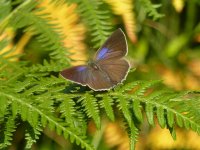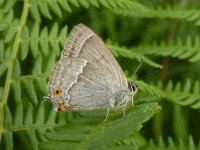I'm fairly new to this butterflying game. Last summer I was delighted to find half-a-dozen Purple Hairstreak at a site I was working in Cornwall. This year it's dawned on me how common the species is, at least in parts of the UK. My first evening at Savernake Forest, Wilts last week saw over a hundred displaying insects in the treetops in the evening sunshine. Next morning, while searching for Emperors, saw over a dozen Hairstreaks coming down to bracken early morning, and watched several egg-laying later in the day. Yesterday evening, returning to my native north-east for the first time in several years, I popped outside for a stroll after 6pm with the express intention of looking for displaying Purple Hairstreaks despite very few having been recorded previously in my old county of Tyne and Wear. The very first oak tree I looked at five minutes into the walk saw two PH flitting about up above , and an hour later I'd seen a total of fifteen. I'm sure there would have been lots more if I'd investigated further.
I wouldn't quite say this last observation has re-written the history books as far as PH status in the north-east is concerned, but I was quite surprised to find this
http://www.northumberlandmoths.org.uk/moth.php?taxon_from_search=Favonius quercus
earlier today, revealing just how scarce species is in nearby Northumberland. Other documents show its historical absence from the immediate area I saw them in so easily last night.
So my question is: what is going on? I did get a few hints from more experienced butterfly guys at Savernake that it was a very good year for PH. But what do folks on here think? I presume it isn't a secret that the species is best looked for and surveyed after 6pm on sunny July/August evenings? Or is it? Certainly there are notes in the documents hinted above that the species was looked for unsuccessfully at various sites in the Durham area earlier in the (21st) century, but it doesn't say whether they looked in the evening or not. How are other people's observations going this year?
I wouldn't quite say this last observation has re-written the history books as far as PH status in the north-east is concerned, but I was quite surprised to find this
http://www.northumberlandmoths.org.uk/moth.php?taxon_from_search=Favonius quercus
earlier today, revealing just how scarce species is in nearby Northumberland. Other documents show its historical absence from the immediate area I saw them in so easily last night.
So my question is: what is going on? I did get a few hints from more experienced butterfly guys at Savernake that it was a very good year for PH. But what do folks on here think? I presume it isn't a secret that the species is best looked for and surveyed after 6pm on sunny July/August evenings? Or is it? Certainly there are notes in the documents hinted above that the species was looked for unsuccessfully at various sites in the Durham area earlier in the (21st) century, but it doesn't say whether they looked in the evening or not. How are other people's observations going this year?





